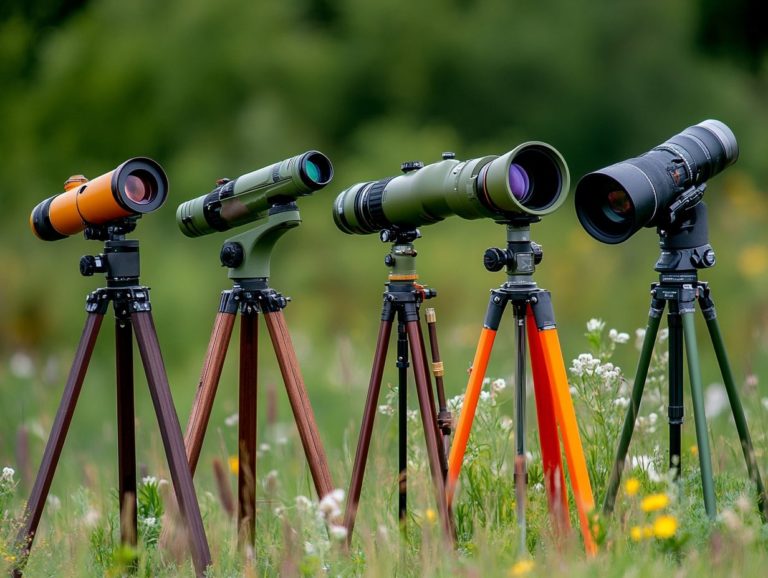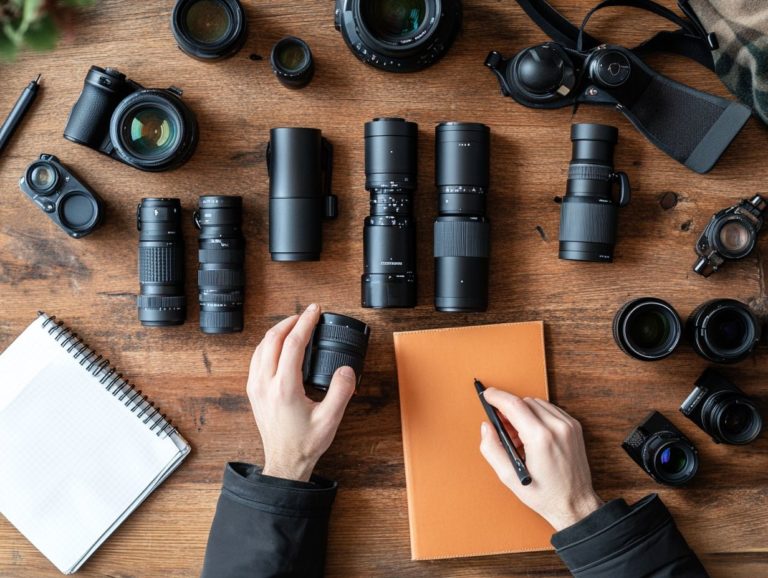How to Clean Your Spotting Scope Effectively
Maintaining your spotting scope is not just about occasional use; it requires regular cleaning to ensure optimal performance and longevity.
This article covers the main benefits of keeping your scope clean, outlines essential tools for effective cleaning, and presents a step-by-step guide to maintain your equipment in peak condition. You ll also find vital maintenance tips and common pitfalls to avoid.
Start protecting your investment now and elevate your viewing experience!
Contents
- Key Takeaways:
- Why Cleaning Your Spotting Scope is Important
- Tools and Materials Needed for Cleaning
- Step-by-Step Guide to Cleaning Your Spotting Scope
- Tips for Maintaining Your Spotting Scope
- Common Mistakes to Avoid
- Frequently Asked Questions
- What supplies do I need to effectively clean my spotting scope?
- Is it safe to use household cleaners on my spotting scope?
- How often should I clean my spotting scope?
- Can I use a regular cloth to clean my spotting scope lenses?
- How do I clean the inside of my spotting scope?
- Can I use compressed air to clean my spotting scope?
Key Takeaways:
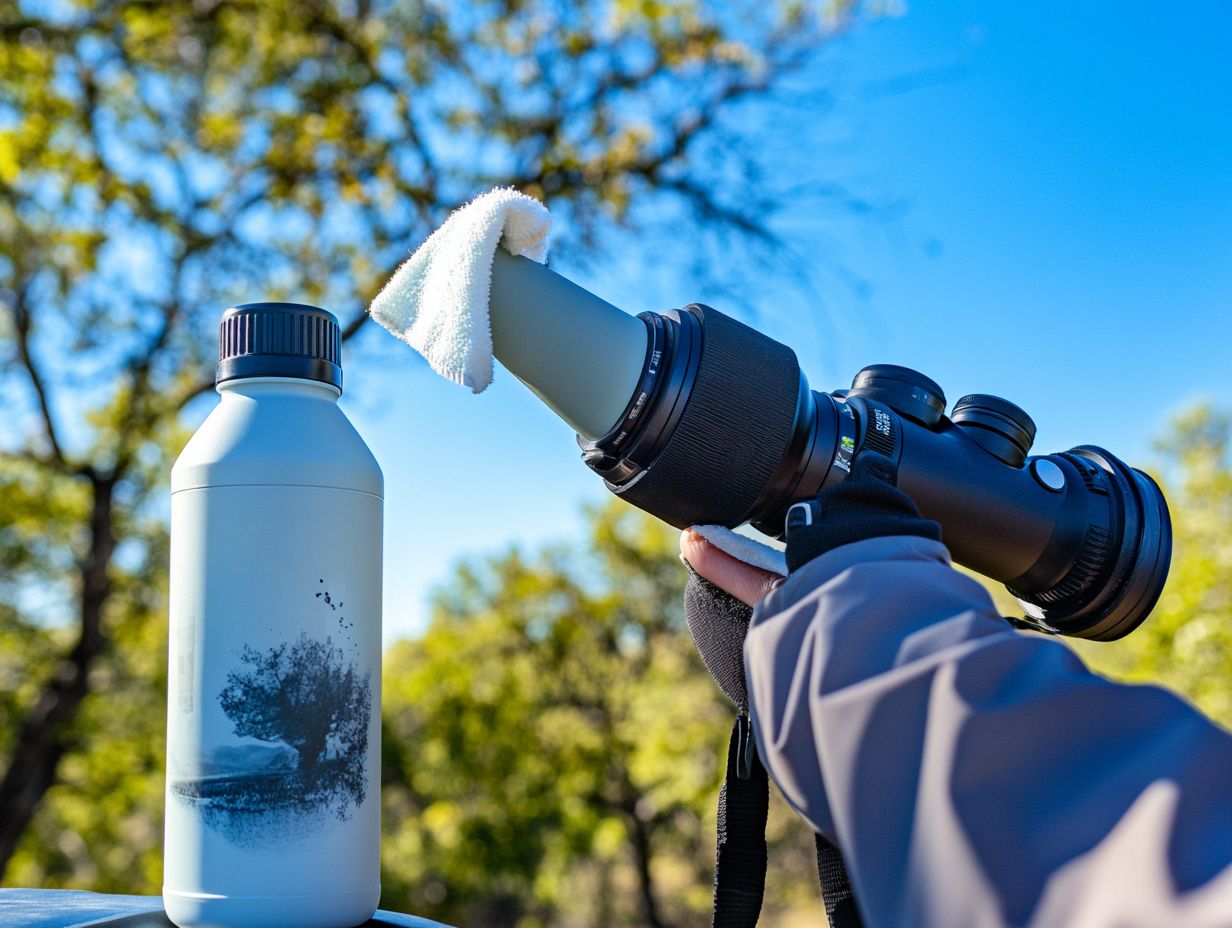
- Regular cleaning of your spotting scope is crucial for maintaining its performance and longevity.
- Gather essential tools such as a lens pen, microfiber cloth, and cleaning solution before starting the cleaning process.
- Prepare, disassemble, and clean the lenses and body of your spotting scope to maintain cleanliness and functionality.
Why Cleaning Your Spotting Scope is Important
Cleaning your spotting scope is vital for preserving its optimal optical quality and performance, especially if you enjoy observing wildlife or hunting. To ensure you get the most out of your equipment, consider setting up your spotting scope correctly. Regular maintenance prevents dirt build-up on the lenses and keeps the optical coatings intact. These layers help improve image clarity, which is crucial for clear viewing and extending the lifespan of your scope.
If you neglect this essential care task, you risk diminished clarity, significantly impacting your experience and possibly harming the scope’s components over time.
Benefits of Regular Cleaning
Regularly cleaning your spotting scope offers numerous benefits, including improved optical performance, extended lens longevity, and a more enjoyable viewing experience by eliminating water spots and debris that can cloud clarity. For detailed guidance, check out this resource on how to clean and care for your binoculars.
Establishing a routine cleaning schedule enhances the visibility and sharpness of images, making your observations of distant subjects more enjoyable and precise. This proactive approach saves you from the need for extensive maintenance later on, which can be costly and time-consuming.
Using appropriate cleaning products designed for optical surfaces is vital. They protect delicate materials like soft lens coatings. Incorporating suitable lens filters during the cleaning process can further shield against dust and scratches, enhancing the durability of each component.
This careful attention to detail ultimately leads to superior performance and greater satisfaction in your viewing experiences.
Tools and Materials Needed for Cleaning
To clean your spotting scope effectively, gather a selection of specialized tools and materials designed for safe and thorough optical cleaning, such as those outlined in spotting scope care.
A quality cleaning kit is essential and usually includes:
- microfiber cloth
- lens brush
- either compressed air or an air duster to gently remove debris without risking scratches on the lenses.
Each of these tools is crucial for maintaining your scope’s optical performance, ensuring the lenses stay pristine and free from dirt build-up and moisture.
Essential Items for Proper Cleaning
Essential items for properly cleaning your spotting scope include effective cleaning solutions, a lens pen for precise application, and an air duster to remove dust and loose debris from the eyepiece lens and objective lens.
Along with these tools, optical brushes are invaluable for gently cleaning intricate parts without scratching the surface, ensuring a thorough and safe clean. Using lens covers is a wise strategy to prevent dust accumulation when the scope is not in use, prolonging its lifespan and maintaining optimal performance.
By effectively utilizing these cleaning accessories, you enhance the visual clarity of your spotting scope and protect its components, allowing for consistent, high-quality viewing experiences in various conditions.
Step-by-Step Guide to Cleaning Your Spotting Scope
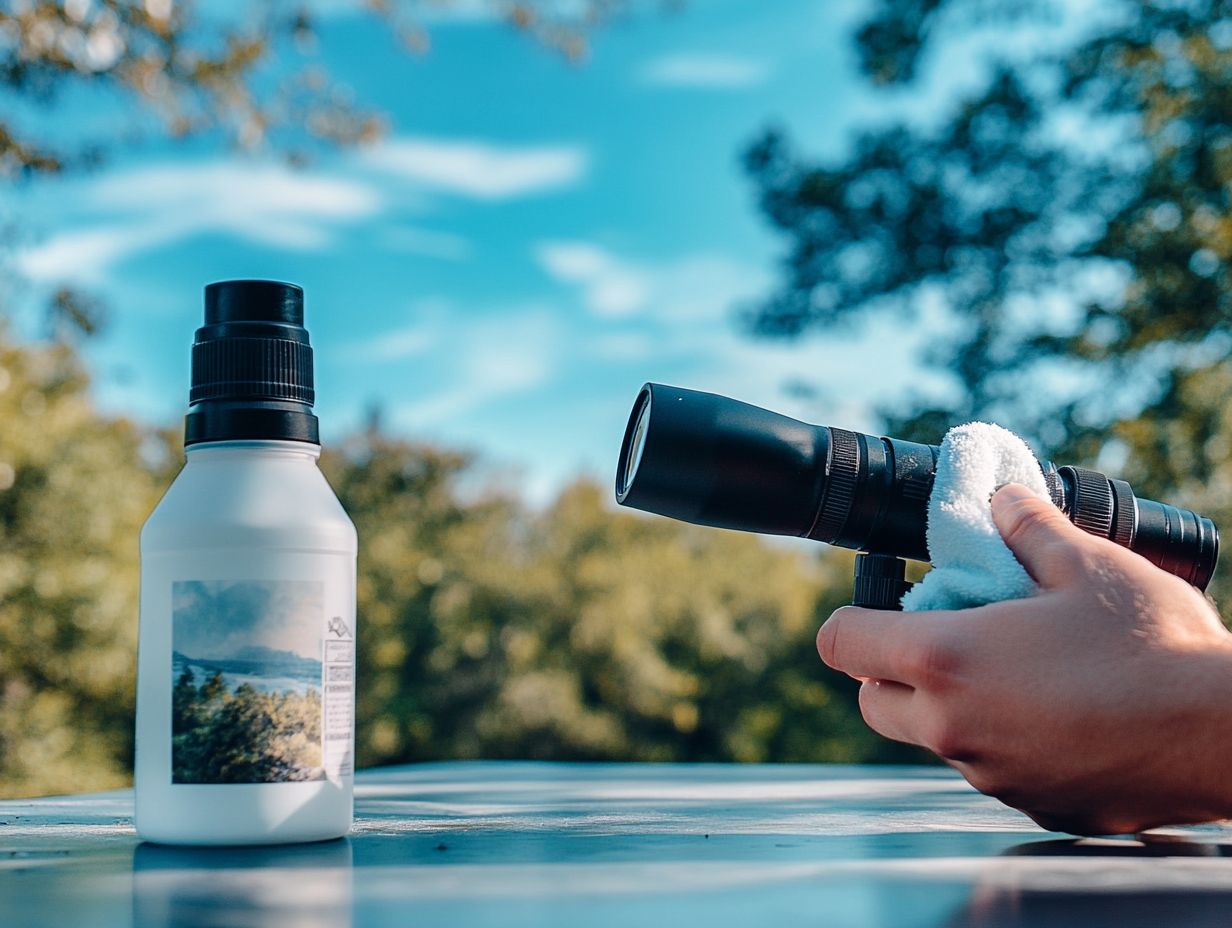
Cleaning your spotting scope effectively requires a systematic, step-by-step approach that safeguards its optical quality and enhances its longevity. This guide to spotting scope maintenance will walk you through essential cleaning techniques, covering everything from preparation to the final drying process.
By following these steps, you ll ensure that every component of the scope from the lenses to the exterior receives the careful attention it deserves.
Preparation and Disassembly
Before you embark on cleaning your spotting scope, prepare and disassemble it with care. To enhance your experience, consider checking out how to make the most of your spotting scope setup. Start by removing the lens covers and cleaning the eyecups to prevent potential contamination of the optical components.
Gently disconnect the eyepiece and objective lenses, holding them by their edges to avoid fingerprints on the glass. Set each component down on a clean, soft surface to prevent scratches.
Refer to the manufacturer s guidelines to maintain optical performance. Following these instructions keeps the scope s alignment and integrity intact. Regular care of the lens covers is also important; keeping them clean enhances your device’s longevity.
When it s time to clean, opt for a dry microfiber cloth or a gentle lens cleaning solution when necessary, as harsh materials can lead to complications.
Cleaning the Lenses and Body
Cleaning the lenses and body of your spotting scope requires finesse. Begin with a soft lens brush to gently whisk away loose dust or debris. For additional care, refer to our guide on how to store your spotting scope safely before using an appropriate lens cleaning solution with a microfiber cloth to safely remove stubborn smudges.
To keep your equipment in peak condition, follow these specific techniques:
- Start with the lens brush, moving in a circular motion to lift particles without scratching the surface.
- Select a lens cleaning solution specifically formulated for optical surfaces to avoid damage.
- Dampen your microfiber cloth with the solution and apply gentle pressure while wiping the lens in a circular motion, ensuring you cover the entire area.
- Use a lint-free cloth for the body of the spotting scope to remove dust while preserving its finish.
By adhering to these steps, you ll keep your spotting scope pristine and enhance its longevity and performance.
Drying and Reassembly
After cleaning, carefully dry the lenses and other optical components with a dedicated lens swab or cloth. This ensures no moisture lingers, which could compromise optical quality during reassembly.
Use high-quality microfiber cloths for drying; they absorb moisture without leaving lint or streaks. Each component should be dried thoroughly to avoid trapped moisture, which can lead to fogging or internal damage. Air dry the components in a dust-free environment to minimize contaminant risks.
Being meticulous with drying techniques enhances the longevity of your optical system and highlights the importance of regular care and maintenance to prevent serious issues, including damage to optical coatings.
Tips for Maintaining Your Spotting Scope
To keep your spotting scope in top shape, implement preventative measures and follow general maintenance practices for optimal performance.
Regularly use cleaning accessories like lens filters to effectively prevent dirt buildup and extend the lifespan of your optical components.
Start today and enjoy crystal-clear views!
Preventative Measures

Use lens covers when your spotting scope is not in use. Store it in a dry, dust-free environment to significantly reduce the need for extensive cleaning and preserve the integrity of optical coatings.
It’s also important to keep your storage area at a stable humidity level. This prevents moisture buildup that can damage sensitive components. Utilizing silica gel packs helps absorb excess moisture, enhancing the longevity of your equipment.
In terms of cleaning, selecting the right solutions and tools is just as important. Opt for microfiber cloths and specialized lens cleaners to effectively remove dirt without scratching the surface. Regularly check for any signs of residue or fogging to allow for timely intervention, keeping your optics in prime condition for optimal performance.
Common Mistakes to Avoid
Avoiding common mistakes while cleaning your spotting scope is crucial to prevent damaging its components or compromising optical quality. Using the wrong cleaning method or aggressive materials can lead to costly repairs and diminished performance.
Take care of your equipment, and enjoy clarity and precision.
Missteps that Can Damage Your Scope
Using damaging materials, like rough cloths or improper cleaning solutions, can easily scratch your lenses and significantly reduce optical quality.
These errors can seriously compromise your equipment’s functionality, making it difficult to achieve those sharp, clear images you desire. For example, using abrasive paper towels risks scratching and can leave behind microscopic debris that clouds your view. It’s also important to avoid all-purpose cleaners or ammonia-based solutions, as these can strip away protective coatings and degrade your lenses.
Instead, use recommended cleaning solutions specifically formulated for optical equipment. Pairing these with microfiber cloths gentle yet effective ensures your gear stays in optimal condition.
By taking these precautions, you enhance both the longevity and effectiveness of your equipment.
Frequently Asked Questions
What supplies do I need to effectively clean my spotting scope?
To properly clean your spotting scope, you will need a lens cleaning solution, a microfiber cloth, a lens brush, and a blower bulb. These items are available at most optics stores or online.
Is it safe to use household cleaners on my spotting scope?
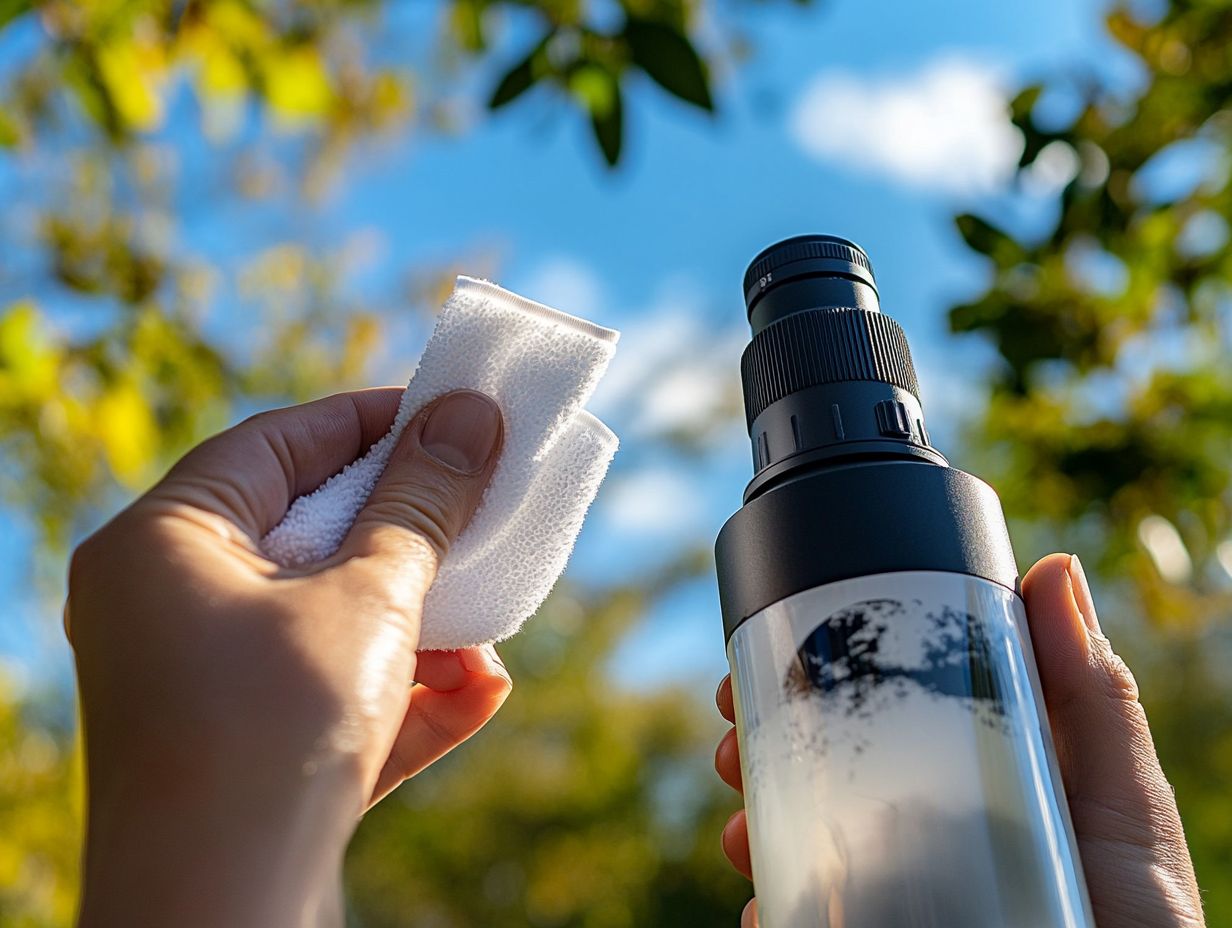
No, avoid household cleaners. They may contain harsh chemicals that can damage the lenses or coatings on your scope. Stick to using a specialized lens cleaning solution.
How often should I clean my spotting scope?
Clean your spotting scope after each use or whenever you notice dirt or debris on the lenses. This helps maintain the quality of your scope and prevents any buildup that could affect your viewing experience.
Can I use a regular cloth to clean my spotting scope lenses?
No, it’s not recommended to use a regular cloth. These can leave scratches or residue on the lenses, affecting the clarity of your view. Always use a microfiber cloth specifically designed for cleaning lenses.
How do I clean the inside of my spotting scope?
Cleaning the inside of your spotting scope requires special tools and should only be done by a professional. Attempting to clean it yourself can cause damage and void any warranties. If you notice dirt or debris inside, take it to a professional for cleaning.
Can I use compressed air to clean my spotting scope?
No, it’s not recommended to use compressed air. The high pressure can damage the delicate lenses and coatings, leading to costly repairs. Stick to using a blower bulb to remove any dust or debris.


